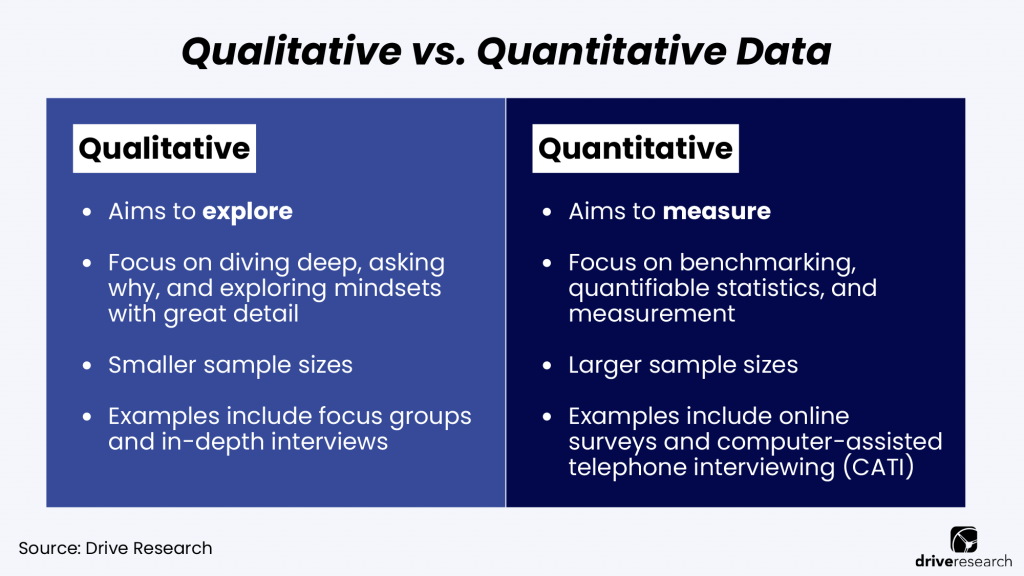
As the B2B market landscape continuously evolves, businesses need to do the same to meet the needs of their target audience. B2B market research allows businesses to do just this, providing actionable, tailored insights about their base.
There are multiple B2B market research methods businesses can choose from, each one providing unique data they can leverage to drive sales, increase customer loyalty, and firmly establish themselves in a competitive landscape.
B2B Market Research Overview
When brands invest in B2B market research, they receive quality data that can be used to strengthen their overall business strategy.
This may include data on:
- Customer preferences
- Competing brands
- Industry trends
- Audience trends
- Product feedback
The beauty of B2B market research is its versatility. Whether a brand wants information on customer pain points, new products, or competitors, B2B market research will provide helpful solutions to make data-driven decisions.
Main Methods of Conducting B2B Market Research
Conducting B2B market research can be done in multiple ways, depending on the needs of a business. These include qualitative, quantitative, and secondary/primary research, along with accessing open web data.
Qualitative
Conducting B2B qualitative research provides businesses with detailed, in-depth results. Since this form of research captures the nuances of data, it’s ideal for measuring B2B customer pain points, purchasing decisions, and related decision-making processes.
Common methods of qualitative research include:
- Focus groups: Led by an experienced moderator, B2B focus groups gather feedback about specific topics from a small group of participants (in the B2B world, this would include key decision-makers, potential clients of a business, etc.)
- In-depth interviews (IDIs): Gathering data from one-on-one conversations, these interviews are great for picking up on small (but often mighty) details from participants that may go unnoticed otherwise.
- Open-ended survey questions: These questions allow online survey respondents to provide more detailed answers.
Quantitative
Designed to gather data on a much broader scale, quantitative research analyzes numerical data to come to a conclusion. This type of research is useful for understanding B2B customer trends, market segmentation, and competitor data.
Common methods of quantitative research include:
- Surveys: Conducting surveys provides businesses with B2B customers, highlighting trends, pain points, and other related feedback.
- Observation: Providing an accurate representation of customer interactions, observational research is ideal for understanding how they interact with a product or service.
- Mining datasets: Many companies have access to quantitative datasets that can provide insight into business operations.

Secondary v. Primary
Conducting secondary research involves gathering information and data from existing platforms. These can include published articles, white papers, and data from prior studies. Secondary research (AKA desk research) is great for highlighting specific gaps that stand to benefit from more exploration.
Primary research refers to the gathering of original data and feedback. Often gathered via surveys, focus groups, and interviews, primary research provides specific solutions to specific issues. It’s best to conduct primary research with the help of a third-party firm like Drive Research.
Finding Your B2B Participants
Recruiting participants for B2B market research involves contacting individuals from a specific target audience. This audience will meet the criteria of whatever demographic a business is trying to resonate with or gather information from.
Here’s a quick rundown of how we source B2B participants:
- Sourcing: Participants are sourced by various recruitment methods, which can range from social media ads to panels. In the B2B space, businesses may already have a set group of participants they want to target, which can eliminate this step.
- Screening: Online surveys are sent out to potential participants that ask a variety of screening questions. This step helps vet participants to ensure they match a brand’s desired audience.
- Scheduling: Once participants have been recruited, they will receive a scheduling invite to the survey, focus group, or whatever the chosen research method is.
Watch this short video to learn more about our recruitment process:
Using Open Web Sources For B2B Market Research Data
Open web sources provide businesses with a full range of potentially useful data and information. Below, we’ll briefly review some of the most common platforms used in open web sourcing for B2B market research.
Social Media
Social media platforms offer a plethora of easily accessible data from countless companies, no matter the industry. These platforms are especially helpful in B2B because they offer real-time insights from key stakeholders, employees, industry analysts, and more.
Examples include:
- X
Reviews
Researching online reviews is a game-changer for companies wanting to conduct B2B research. Reviews offer authentic feedback, highlight common industry trends, and easily highlight common consumer gripes – all within the B2B space.
Using this information, companies can improve various business functions to gain better positioning in their market.
Competitor Websites
Keeping an eye on rival businesses is critical when it comes to staying on top.
Researching competitors allows businesses to learn where they’re excelling, the services they offer, and pinpoint certain gaps. We recommend conducting some form of competitor analysis or research on a fairly regular basis, depending on the needs a business has.
Discover Influencers
Influencers also play a role in open web sourcing within the B2B space.
By doing this, businesses can locate various thought leaders/influencers who interact with their desired target audience and pursue potential partnerships. Not only does this add an extra layer of credibility to a business, but it also provides them with additional visibility that they may not have had otherwise.
The best way for businesses to create these partnerships? Analyze social media pages, blogs, and other professional networking platforms to discover influencers relevant to their industry.
Contact Our Market Research Company
B2B market research is a breeze (when working with the right team). At Drive Research, our team is well-versed in B2B practices and can work with businesses in this space to deliver quality, data-backed insights. From our first kickoff meeting to delivering your final report, our team will be with you throughout each step of the research process. Contact us today to learn how your business can benefit from B2B market research



